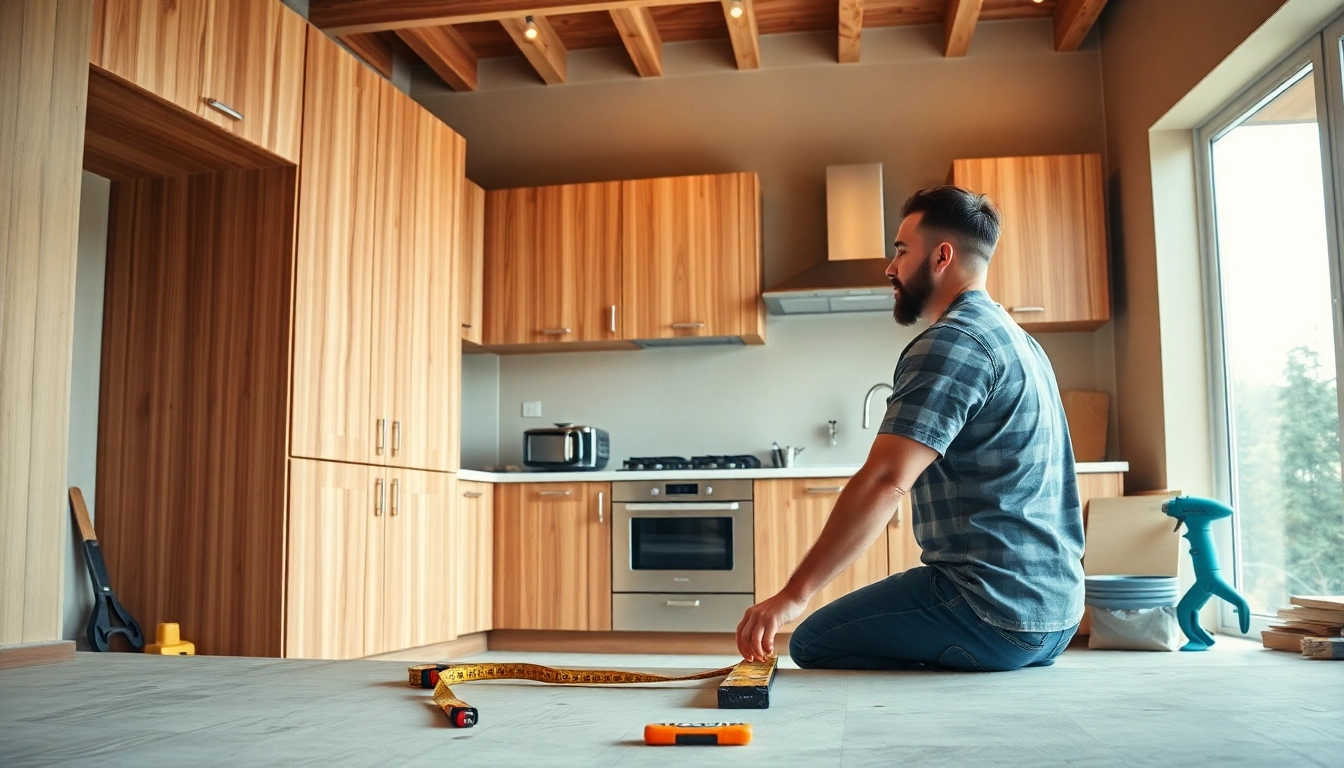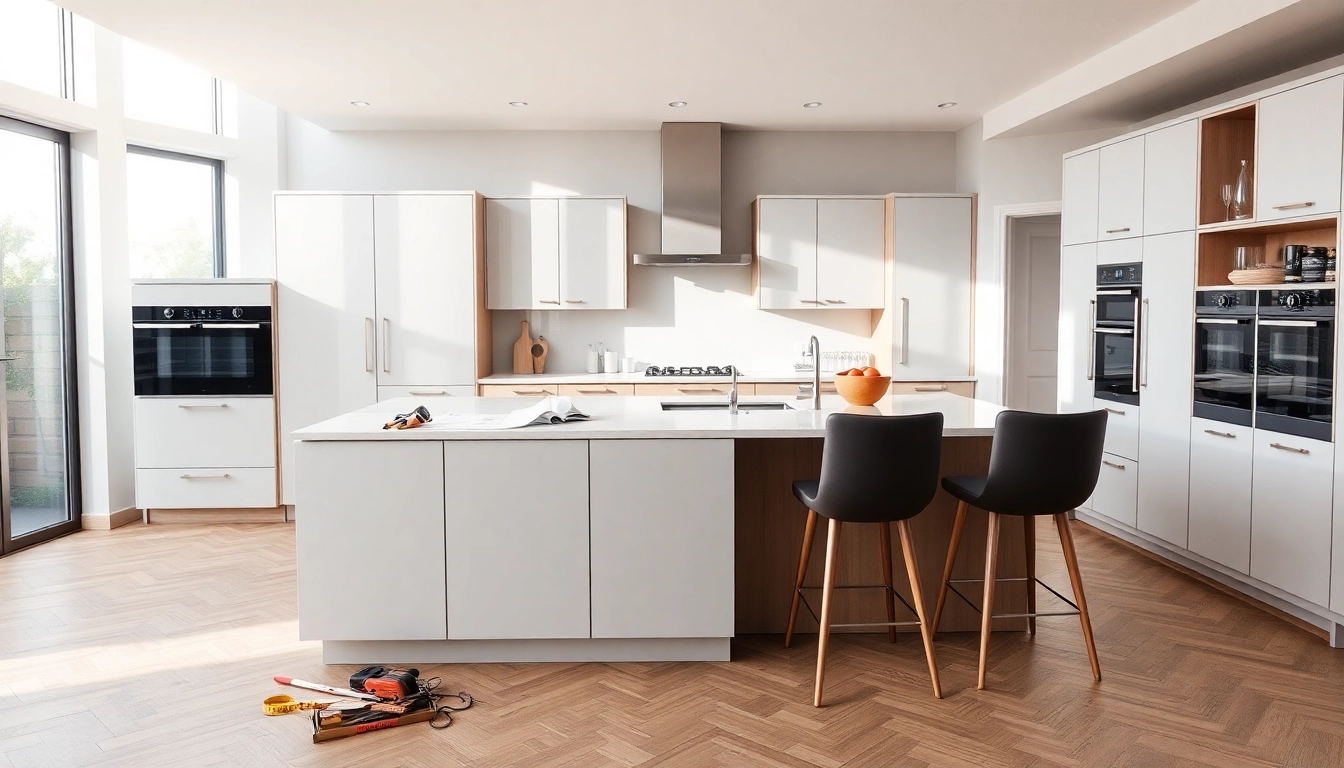Understanding the Role of Kitchen Fitters
Kitchen fitters are specialized professionals responsible for installing, assembling, and fitting the various components of a kitchen. Their work is crucial in transforming kitchen designs into functional and aesthetically pleasing spaces. From laying out the cabinetry to installing appliances, kitchen fitters play a pivotal role in ensuring that a kitchen not only meets the design specifications but also adheres to safety and quality standards. Understanding the nuances of what makes a kitchen fitter exceptional is vital for homeowners seeking to create their dream kitchen. For expert services, consider exploring kitchen fitters who are certified and experienced.
What Makes a Good Kitchen Fitter?
A good kitchen fitter possesses a mix of technical skills, craftsmanship, and interpersonal abilities. Key attributes include:
- Expertise: Strong knowledge of construction documents, installation techniques, and materials used in kitchen fittings.
- Attention to Detail: Precision in measuring, cutting, and installing to ensure everything aligns perfectly.
- Problem-Solving Skills: Ability to troubleshoot challenges that arise during installation, whether they are design-related or compliance issues.
- Communication Skills: Capacity to clearly convey ideas and understand clients’ needs which helps in managing expectations and building rapport.
- Cleanliness and Professionalism: Maintaining an organized work area and adhering to a standard of conduct that reassures clients of their professionalism.
Common Services Offered by Kitchen Fitters
Kitchen fitters provide a range of services to accommodate various client needs, including:
- Custom Kitchen Design: Collaborating with homeowners to tailor designs that fit their specific style and space requirements.
- Installation of Cabinets and Countertops: Expertly fitting cabinets, countertops, backsplashes, and other integral parts of the kitchen.
- Electrical and Plumbing Connections: Coordinating with licensed professionals to ensure appliances and fixtures are correctly installed and compliant with local codes.
- Flooring Installation: Installing tile, hardwood, or other flooring types that enhance the kitchen’s functionality and appearance.
- Post-Installation Services: Including maintenance checks and improvement suggestions post-installation to keep the kitchen in top shape.
The Importance of Professional Installation
Hiring a professional kitchen fitter ensures that installations are performed correctly and efficiently. Professionals understand building codes and safety standards, reducing the risk of errors that could lead to costly repairs down the line. Additionally, expert installation typically comes with a warranty, providing further assurance to homeowners. Hiring a professional can ultimately save time, money, and ensure peace of mind during the remodeling process.
Choosing the Right Kitchen Fitter for Your Needs
Selecting the right kitchen fitter is a significant step in your kitchen renovation journey. With so many options available, knowing how to choose wisely can set the foundation for a successful project. Consider the following factors:
Factors to Consider When Hiring Kitchen Fitters
When looking for a kitchen fitter, keep the following in mind:
- Experience and Qualifications: Checking for necessary certifications and years of experience can gauge a fitter’s reliability.
- Portfolio of Previous Work: Requesting to see past projects gives insight into their style and quality of work.
- References and Reviews: Reading testimonials and speaking with past clients can reveal how satisfied others have been with their work.
- Insurance and Warranty: Ensuring the fitter is insured protects you from liability in case of accidents or damages during installation.
- Clear Pricing Structure: A transparent quote that outlines labor, materials, and other costs prevents unexpected expenses.
Questions to Ask Potential Kitchen Fitters
To further narrow down your list of potential kitchen fitters, consider asking the following questions:
- What is your experience with kitchen installations similar to mine?
- Can you provide a timeline for my project?
- What provisions do you have for unexpected costs or changes during the project?
- Do you have recommendations for appliances or materials that would work best in my kitchen?
- Will you be able to handle all aspects of the installation, or will subcontractors be involved?
How Reviews Impact Your Choice of Kitchen Fitters
In the digital age, online reviews are invaluable when selecting kitchen fitters. Websites like Yelp, Google Reviews, and specialized contractor directories provide insights about previous clients’ experiences. Analyzing both positive and negative reviews can give you a well-rounded view of what to expect. Look for consistent themes in feedback, such as punctuality, quality of work, and customer service. A fitter with numerous positive reviews is often more reliable and trustworthy based on collective client experiences.
Kitchen Fitting Costs: What to Expect
Understanding the financial aspect of kitchen fitting is crucial for budgeting effectively. Costs can vary greatly based on numerous factors, including the size of the kitchen, materials used, and the complexity of the installation.
Average Cost of Kitchen Installation
On average, kitchen fitting costs in the UK can range from £1,500 to £5,000, depending on the scope of work. Minimal installations (like just fitting cabinets or countertops) may be on the lower end, whereas full kitchen renovations, which may require plumbing, electrical work, and extensive cabinetry, will likely fall on the higher end of that spectrum.
Cost Breakdown: Labor vs. Materials
In most cases, labor can account for approximately 30-40% of the total kitchen fitting cost, with materials making up the remaining 60-70%. It is essential to properly budget for both aspects. For instance, high-quality cabinets and countertops can significantly impact the material costs, while skilled labor may demand higher fees due to their expertise.
Saving Tips When Hiring Kitchen Fitters
Here are several strategies to save money while ensuring quality work:
- Get Multiple Quotes: Always obtain at least three quotes from potential fitters to compare prices and services.
- Choose Mid-Range Materials: Opting for mid-range finishes can offer great aesthetics without compromising on quality.
- DIY Preparation Work: If you’re handy, consider completing demolition or prep work yourself to reduce labor costs.
- Schedule in Off-Peak Times: Planning your installation during less busy months may yield lower rates.
- Consider Package Deals: Some kitchen fitters may offer package deals that include design consultation and installation, which can save you money compared to hiring separate services.
Best Practices for a Smooth Kitchen Installation
Here are best practices to ensure a seamless kitchen fitting experience:
Preparing Your Home for Kitchen Fitters
Prior preparation can significantly ease the process. Here’s how to do it:
- Clear the Area: Make sure the kitchen is free from personal items, food supplies, and furniture.
- Communicate Access Points: Inform your fitter of the best access points for heavy equipment and supplies.
- Notify Neighbors: If installation will cause disruption, consider informing neighbors, especially if heavy machinery or noise is involved.
Ensuring Clear Communication with Your Fitter
Open communication with your kitchen fitter is integral to a successful project. Establish a clear communication channel and check-in regularly during the installation to ensure everything is on track. Address any concerns immediately to avoid complications later.
Post-Installation Follow-Up and Maintenance
After installation, conduct a walk-through with your fitter to ensure everything meets your expectations. Discuss maintenance requirements for materials used and ask for care tips to prolong the life of your kitchen. A professional kitchen fitter should always be willing to follow up, answer questions, and provide guidance on maintenance.
Trends and Innovations in Kitchen Fitting
The kitchen fitting landscape is continuously evolving. Keeping up with the latest trends can inspire your kitchen design:
Current Trends in Kitchen Designs and Installations
Homeowners are increasingly looking for functional and immersive kitchen spaces. Notable trends include:
- Open Concepts: The integration of kitchen spaces with dining and living areas promotes a social atmosphere.
- Sustainable Materials: An increasing emphasis on eco-friendly materials supports sustainability.
- Smart Technology: Smart appliances and fixtures enhance efficiency and ease of use.
- Minimalist Design: Simple, clean lines are gaining popularity over ornate, complex cabinetry.
Technological Advances in Kitchen Fitting
New technologies are shaping the kitchen industry, revolutionizing how kitchens are designed and fitted. Innovations such as 3D design modeling and precision cutting tools allow for more customizable and precise installations compared to traditional methods.
Future Outlook: Where Kitchen Fitters Are Heading
The future of kitchen fitting points towards further automation, enhanced design capabilities, and sustainable practices. As consumers become more informed about trends and technology, kitchen fitters will need to adapt quickly to meet evolving client expectations and preferences.




